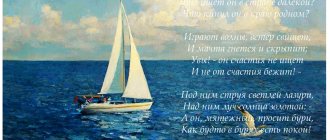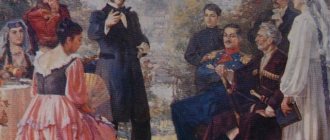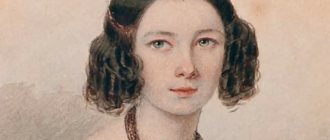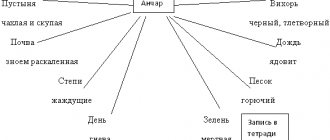Fet as a controversial personality in art and life
The life of the Russian lyricist was accompanied by love mysteries, detective twists and turns, which one day he would call the plots of his complex novel. The spirit of adventure was present in the writer’s life before his birth. Afanasy's mother, being pregnant, arranges an escape with her lover and leaves her legal husband, who was the father of her child.
At birth, the boy receives the noble surname Shenshin, which belongs to his mother’s lover. When the young man turns 14, he suffers a fatal blow: the most important thing in life is taken away - his stepfather's surname, as well as the privileges of the nobility.
After such events, Fet is obsessed with the idea of returning his last name, which defines him as a privileged person in society. As a student, he preferred philosophy, so he entered Moscow University.
During his student years, the poet met such writers as Yakov Polonsky and Vladimir Solovyov. After graduating from university, the poet does not forget about the calling to win the title of nobility and goes to military service.
The love of her life, Maria Lazic, was overtaken by the lyricist at the service; despite her unbridled passion, her beloved does not receive an offer. Afanasy could not imagine his life with a man who did not have material wealth, and ended his relationship with Maria.
The next fatal blow was the death of his beloved. After this, Afanasy, until the end of his life, was unable to calm the sea of pain and loss that was seething in his heart.
The poet idolized the image of his beloved; she was his muse. When the author recalled her death, bitter tears poisoned his soul. Having studied the poet's poems, you can trace the theme of tragic love.
Fet is one of those creative individuals who made “art for art’s sake.” His life path, where he sought to gain material wealth and married an unattractive but wealthy woman, differed from his creative life.
The lyricist called for his poems to be assessed according to the laws of art, and not to determine what social value they have. The main motives of Afanasy’s work are the celebration of the beauty of nature and pure love. The technique of writing Fet's creations is impressionistic. There is no description of the picture as a whole; the author seems to be recalling excerpts from that moment that struck him.
The poet's lyrics are full of associative elements. When a poet chooses an object, it is not its direct meaning that is meant, but what feelings and emotions it evokes. In his poems, Fet used the technique of sound writing, so when read, the text is distinguished by melody and easily fits the notes.
Fet's death occurred after an unsuccessful suicide attempt; he remained in the memory of many as a controversial personality, interest in whom remains to this day.
Theme and concept of the work
The main theme of the poem is close in spirit to all dreamy and romantic readers. Topics include:
- Unity and uniqueness of the surrounding world.
- Philosophical thoughts about the meaning of life and the existence of creativity.
- Love is like a bright and desirable feeling.
- The immense beauty of Mother Nature.
The verse describes a romantic and beautiful time of year - spring, the image of which was the most exciting for Afanasy, which is reflected in many of his works.
The main theme of Fet’s verse “I came to you with greetings...” is the awakening of the soul, cleansing and resurrection, a new pure and gentle look at the world around us.
The work sharpens feelings and gives mood, calling a person to follow the path to his cherished dream.
Composition and genre
The composition of the work carries a separate interest, because each line contains its own separate mini-theme. At the beginning it talks about the coming dawn, then about spring and the return of birds, the awakening of trees in the forest. The next part reveals a romantic hero who opens his heart to spring and happiness. In conclusion, Love and Spring, as individuals, create inspiration together. Fet makes it clear that glorifying everything beautiful is his credo.
The narrative of a work carries limitations. All stanzas begin with the word “tell.” The main idea of the composition is to attract attention to yourself. This technique focuses the reader’s attention and explains why and for what purpose the poet burst into the literary world and has a desire to be heard.
The author addresses the reader with all due respect. Such methods of communicating with one's audience point to a more suitable genre: landscape lyric poetry. But Afanasy Fet’s work was not only written to convey the essence of his work. This can also be attributed to the philosophy about strong emotions, feelings and love that overwhelm a person, about universal happiness. This is practically a hymn to life and all-encompassing, which has the ability to constantly renew itself.
Basic means of expression
The author achieves expressiveness in various ways. The arrangement of phrases, poetic rhythm, the use of epithets and metaphors - all this allows us to lead readers to the picture that the poet created in his fantasies. There are many examples of colorful conveying of feelings that can be inserted using metaphor:
- a song is brewing;
- the soul is ready to serve;
- shook himself with every branch;
- woke up like a bird;
- The word “fun” itself does not mean a holiday around, but hard work and creativity.
Personification is also a significant pictorial means; plants could come to what they wanted, and the moon could rise when it has had enough sleep. For the author, the connection between people and nature is an inseparable concept:
- the sun may rise;
- the forest wakes up;
- the morning trembles.
In the text of the poem, anaphora is clearly visible - a method of organizing rhythm in the text, this is shown by the word “tell” repeated in each stanza, which gives special dynamics. The conjunction “what” is often repeated, it cannot be missed, it gives the work melodiousness and makes something musical out of it.
The verse has a structure of four stanzas of four lines in size, which are connected to each other by rhyme, which is called a quatrain; it is easy to read such a structure. Each line uses two unstressed syllables, making reading easy and soaring. Techniques such as assonance and alliteration slip through, which awaken in the reader confidence in foreign feelings.
All these techniques lead to certain feelings and thoughts about the attitude towards human life. It is difficult to convey such emotions through letters, passages and fragments, but the author succeeds perfectly.
Poem idea
The work begins with the pronoun “I,” which shows how the poet strives to address a person and wants to tell everything that worries him, to share with the whole world, as his soul cries. The author is overwhelmed by emotions and feelings, like raging waves ready to turn into a flood.
There is another idea, where “I” is the romantic hero’s address to his beloved woman . He tries to express all his gratitude for the received emotions, feelings and passion that lives in the soul and heart and gives inspiration.
Analysis of the poem “I came to you with greetings”
The text contains subjects of poetry: song, love and nature. For Fet, the concept of beauty lies in these three nouns, irreplaceable and inseparable. Confirmation of this line:
• That I myself don’t know that I will sing - but only the song is ripening.
• Tell me that with the same passion as yesterday, I came again, that my soul is still happy and ready to serve you.
• Tell that the forest has woken up All woken up, with every branch, with every bird roused
The main elements were words and combinations - “song”, “hello”, “happiness”, “sun”, “trembling of leaves”, “light”. The emotional context of each of these elements has something in common and forms the inspiration of the young man - love, fun, joy.
Fet actively uses features that help present the picture:
•
epithets - “spring thirst”, “hot light”;
•
personifications – “the forest woke up”, “the sun fluttered across the leaves”;
•
metaphors - “the song is ripening”, “the soul is ready to serve happiness”;
•
Alliteration - repetition of the sounds “s” and “v”.
Such techniques help to imagine spring awakening, hear the rustling of leaves, feel the wind rushing through the forest.
It should be noted that this is a work of four stanzas, to which the author applied psychological parallelism - a clear correspondence of the stanzas to each other. After reading the first two stanzas, the reader is immersed in a spring morning. The subsequent stanzas tell about the hero’s experiences and his state of mind.
The first quatrain is a description of the sun, which awakened everyone around. Fet uses the epithet “hot”, exalting the role of the sun. In the last line “the sheets trembled,” the author used an associative device, with the help of which the reader can feel all the emotional shades of the text. The second quatrain tells about the moment when the energy of the sun awakened the entire forest. Revival is expressed in the feelings of the lyrical hero, his spring joy.
The third quatrain is filled with rays of the sun, spring joys with which the lyrical hero is charged.
The final quatrain, like the last strokes of the brush, enhances the meaning of the previous stanzas, emphasizes the spiritual joy, the cheerful mood of the hero, and the praise of the song. Fet focuses the reader’s attention precisely on the last words, because they contain the main idea of the poem.
Detailed analysis of the poem
History of creation
Afanasy Fet was a bright romantic of Russian literature. He had a keen sense of nature, but could also convey the yearning of love. The poem “I came to you with greetings,” written in 1843, is a clear confirmation of this.
To whom the twenty-three-year-old poet dedicated his reverent lines is still unknown. However, this does not matter, since the most important thing is how he managed to convey the feeling that he feels for his beloved.
Twenty-three years is the age when a person already loves consciously, but at the same time his love is not overshadowed by social prejudices and conventions. And although he carefully hid the name of his lady of his heart, the fact that he is addressing a real woman is undeniable.
The work turned out to be beautiful and sincere, so it is not surprising that it appeared in the magazine “Otechestvennye zapiski” in the same year in which it was created.
Composition
This poem consists of two parts. In the first, Afanasy Afanasyevich paints a picture of nature, which joyfully greets the morning. And since he describes this picture for the one with whom he is obviously dearly in love, his admiration for the beauty of the surrounding world is painted in the most tender and sensual shades.
The sun, as the personification of life, sends a hot light that flutters through the leaves, awakening the forest. And since the time of year described in the poem “I came to you with greetings” is spring (which Fet directly points out), it is impossible not to associate the awakening of nature with the awakening of feelings.
And it is about him that the poet speaks in the second part, which, like the first, consists of two stanzas. He talks about his love, simply and sincerely, without pathos or pretense. Informing his beloved that his feelings have not changed, the lyrical hero directly connects this happiness with creativity: a song is already “ripening” in him.
Fet subtly connects the awakening of nature and the feelings of the lyrical hero, who is full of tenderness. He comes to the girl not even on a date - he simply cannot help but share with her how wonderful life is, how amazing the spring morning is and how full of happiness everything is.
The young man expresses his feelings very violently, but does not feel embarrassed about this: at his age it is natural to enjoy everything.
Genre
This is one of the most beautiful examples of the poet’s love lyrics, the genre is lyric poem. He very naturally conveys all the feelings that his lyrical hero experiences. He not only admires the beauty of spring nature or feels the delight of meeting his beloved - for him these two feelings completely naturally merge into one.
Afanasy Afanasyevich uses trochaic tetrameter to embody his creative idea, which allows, on the one hand, to convey the mood simply and without embellishment, and on the other, makes the work similar to colloquial speech, as if he were really talking with a mysterious girl. Cross rhyme reinforces this impression.
Means of expression
To convey feelings and express emotional mood, Fet chooses the most intense paths:
- Epithets – “hot light”, spring thirst.”
- Metaphors - “the forest is full of spring thirst”, “the soul is ready to serve”, “merriment blows”, “the song is ripening”.
- Personifications – “the sun rose”, “the sun trembled”, “the forest woke up”.
- Comparison - “with the same passion as yesterday.”
Their diversity also enlivens the verse and sets the reader in a lyrically sublime mood. The means of expression chosen by the poet are in perfect harmony with the style of his work.
Light and bright, it makes you admire the world that surrounds a person, and directs you to share this admiration with others, to share the happiness of life with someone.
What did Fet want to tell you when he came with greetings?
Afanasy dedicated his work to his favorite love theme.
In the poet's poems there is a spirit of spring joy, a fresh breath of thaw. The reader is presented with a picture consisting of the warm colors of a spring morning, in which the author meets his love. The young man finds a reason to meet his beloved and wishes her good morning, bringing the good news that the sun has risen. In Fet's work, admiring one's companion and nature is designated as enjoying beauty. This is what excites the author to tell the whole world about an unprecedented happy moment that comforts the soul of the lyrical hero. Afanasy Fet acts as a faithful servant of love, who managed to immerse the reader in the world of beauty and happiness. The hero has found harmony with nature, reached the highest point of bliss, which he wants to share.
The lyrical hero finds solitude with nature, joy, fun in every moment and hurries to share this with his beloved. The image of a spring morning is presented as a symbol of the beginning, the birth of something bright in anticipation of a miracle.
If nature blossoms and awakens, then the state of the surrounding world is transmitted to the human soul. Fet provided the reader with the image of a lyrical hero who feels part of this world, wants to share the best emotions with everyone, and whose heart is full of love.
The author conveys the joy of a character who feels good because he has met his beloved and can share with her the sunny weather and the beauty of the world around him.
Genre
This is one of the most beautiful examples of the poet’s love lyrics, the genre is lyric poem. He very naturally conveys all the feelings that his lyrical hero experiences. He not only admires the beauty of spring nature or feels the delight of meeting his beloved - for him these two feelings completely naturally merge into one.
Afanasy Afanasyevich uses trochaic tetrameter to embody his creative idea, which allows, on the one hand, to convey the mood simply and without embellishment, and on the other, makes the work similar to colloquial speech, as if he were really talking with a mysterious girl. Cross rhyme reinforces this impression.
Features of the poem “I came to you with greetings”
In Afanasy’s lyrics at all times, a special place was occupied by colorful descriptions of words in an unusual meaning for them, as well as the desire to share spiritual joy with the reader. In the work, the reader observes how the words “spring”, “sunlight”, “happiness forms a melody” - all this personifies the soul of the poet, like the song of a young man who is inspired by a feeling of love and joy. The author was also able to choose words that contribute to the strengthening of spring and, “trembled.”
The poem consists of only one sentence in order to create the effect of the integrity of the reunification of nature and man. To write the poem, the poet chose a two-syllable trochee, which, in conjunction with feminine rhyme, adds song motifs, hence the musicality and tenderness of the work.
The work “I came to you with greetings” is a story of harmony of love, spring and man, which exists in one breath, like a light breeze, a certain moment in which you want to stay forever. This poem is a world in which the author is doing well, this is a place where he may not think about the loss of love.
Each line evokes admiration and a desire to comprehend the feeling that the lyrical hero has acquired. Fet gave Russian literature a bright fairy tale about a happy man who enjoys every moment.
Themes, mood
The main theme of the poem “I came to you with greetings” is love. The lyrical hero shares his feelings with the object of his adoration, revealing them using the example of how nature transforms with the arrival of morning and sun.
The second theme of the work is the theme of nature. After all, all our emotions, feelings and moods are fully reflected in the natural world. It was nature, with its colors, incredible landscapes and beauty, that prompted the poet to create such a work. Nature inspires him, fills him with strength and energy.
There is also a theme of happiness. For the author, happiness is to be close to his beloved, to serve her. He even talks about this directly in his work.
As for the mood of the work, it is upbeat, cheerful and cheerful. The first love and enchantment can be compared to a similar mood.
When did Afanasy Afanasyevich decide to come with greetings?
The poem became a poetic manifesto for the Russian lyricist, a monologue of an inspired young man to his beloved.
This work of art appeared in 1843, when Afanasy was 23 years old. In his work, he conveyed all the tenderness and romanticism of that age. During this period, the young man’s life is still full of the fearlessness of human condemnation and the courage of loving deeds. The work played an important role in Fet’s work. The poet created a masterpiece as a hymn about eternal love, which never fades and is always with the hero. The reader first became acquainted with him in a magazine called “Domestic Notes.” The publication was placed on the first page as a title, and this says a lot. Magazines place in such a place only those materials that they appreciate and consider worthy of publication in the most prominent place. This publication once again emphasized the significance of Fet’s contribution to Russian literature.
Fet is a man with two life stories
Fet is a conservative in life, who defined happiness as material wealth.
He is a lyricist who sang pure love for nature. The world of poetry for Fet was an abstraction from the outside world, problems, and social contradictions. Despite the fact that as a person he could sympathize with few people, but as a poet he managed to conquer a single human soul with his creation. At the same time, his work was repeatedly criticized, because not everyone likes to read about a bright and beautiful feeling.
Some wanted to see social, topical topics in their poems; this is exactly what the poet avoided. In his world of poetry, he felt comfort, which he was deprived of in real life. He himself lives in the poems of Afanasy Fet, and the masterpiece “I came to you with greetings” is proof of this.
The mood of the work
The stanzas are rhythmic and easy to understand. They seem to be addressed to all people and at the same time to each individual person. In literary criticism, there is an opinion that the poem is dedicated to Fet’s beloved, but it was not possible to understand who she is. The main mood can be conveyed using several components:
- Opening of feelings. The lines are permeated with warmth and convey bright positive emotions. The author freely talks about his feelings and generously shares his own discoveries with the reader.
- Emotional transformation. Noticing changes in nature, he notices changes in his internal state. Just as everything around is filled with life with the arrival of spring, so a person passionately longs for new achievements, makes attempts to keep joy close to him, and opens up to love.
- Integrity of perception. The poet incredibly poignantly paints a picture of the unity of natural phenomena with the blissful impulses of the soul. New thoughts that appear as a result of observing the sunlight, branches waking up in the forest and fluttering birds turn into the intention to write them down in words on paper.
The theme of the poem is the enthusiastic monologue of the lyrical hero addressed to his chosen one . These lines themselves sound like a beautiful song, open the doors of the soul, free you from all kinds of heartfelt turmoil.
The young man is filled with a great thirst for life. Intoxicated by a bright feeling, he finds its manifestations everywhere, no matter what he touches with his eyes.








